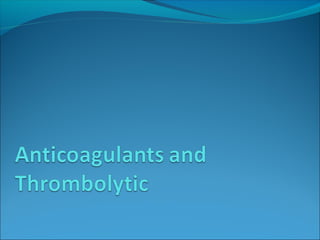
Anticoagulants 22
- 2. Objectives To learn how Blood Clots are formed. How the blood clots are broken down ? What drugs can be used to regulate clotting ? How to rectify clotting deficiencies
- 3. Classes of Drugs Prevent coagulation Dissolve clots Prevent bleeding and hemorrhage - Hemostatic Overcome clotting deficiencies (replacement therapies)
- 4. Blood Clotting Vascular Phase Platelet Phase Coagulation Phase Fibrinolytic Phase
- 5. Vascular Phase Vasoconstriction Exposure to tissues activate Tissue factor and initiate coagulation Tissue Factor
- 6. Platelet phase blood vessel wall (endothelial cells) prevent platelet adhesion and aggregation platelets contain receptors for fibrinogen and von Willebrand factor after vessel injury Platelets adhere and aggregate. Release permeability increasing factors (e.g. vascular permeability factor, VPF) Loose their membrane and form a viscous plug
- 7. Coagulation Phase Two major pathways Intrinsic pathway Extrinsic pathway Both converge at a common point 13 soluble factors are involved in clotting Biosynthesis of these factors are dependent on Vitamin K1 and K2 Normally inactive and sequentially activated Hereditary lack of clotting factors lead to hemophilia -A
- 8. Intrinsic Pathway All clotting factors are within the blood vessels Clotting slower Activated partial thromboplastin test (aPTT) Extrinsic Pathway Initiating factor is outside the blood vessels - tissue factor Clotting - faster - in Seconds Prothrombin test (PT)
- 9. Blood Vessel Injury IX IXa XI XIa X Xa XII XIIa Tissue Injury Tissue Factor Thromboplastin VIIa VII X Prothrombin Thrombin Fibrinogen Fribrin monomer Fibrin polymer XIII Intrinsic Pathway Extrinsic Pathway Factors affected By Heparin Vit. K dependent Factors Affected by Oral Anticoagulants
- 10. Drug Class Prototype Action Effect Anticoagulant Parenteral Heparin Inactivation of clotting Factors Prevent venous Thrombosis Anticoagulant Oral Warfarin Decrease synthesis of Clotting factors Prevent venous Thrombosis Antiplatelet drugs Aspirin Decrease platelet aggregation Prevent arterial Thrombosis Thrombolytic Drugs Streptokinase Fibinolysis Breakdown of thrombi
- 11. Heparin Sulphated carbohydrate Different sizebovine lungs Administration - parenteral- Do not inject IM - only IV or deep s.c. Half-life 1 - 5 hrs - monitor aPTT Adverse effect: hemorrhage Antidote : protamine sulphate
- 13. Oral anticoagulants Examples: Coumarins - warfarin, dicumarol Structurally related to vitamin K Inhibits production of active clotting factors Clearance is slow - 36 hrs Delayed onset 8 - 12 hrs Overdose - reversed by vitamin K infusion Can cross placenta - do not use during late pregnancies
- 14. Descarboxy Prothrombin Prothrombin Reduced Vitamin K Oxidized Vitamin K NADHNAD Warfarin Normally, vitamin K is converted to vitamin K epoxide in the liver. →This epoxide is then reduced by the enzyme epoxide reductase. →The reduced form of vitamin K epoxide is necessary for the synthesis of many coagulation factors (II, VII, IX and X, as well as protein C and protein S). →Warfarin inhibits the enzyme epoxide reductase in the liver, thereby inhibiting
- 15. Severe Side effects: •Severe bleeding •Bleeding from the rectum or black stool •Skin conditions such as hives, a rash or itching •Swelling of the face, throat, mouth, legs, feet or hands •Bruising that comes about without an injury you remember •Chest pain or pressure •Nausea or vomiting •Fever or flu-like symptoms •Joint or muscle aches •Diarrhea •Difficulty moving •Numbness of tingling in any part of your body •Painful erection lasting four hours or longer
- 16. Other less serious warfarin side effects: •Gas •Feeling cold •Fatigue •Pale skin •Changes in the way foods taste •Hair loss
- 17. Drugs that Increase Warfarin Activity Decrease binding to Albumin Inhibit Degradation Decrease synthesis of Clotting Factors Aspirin, Sulfonamides Cimetidine, Disulfiram Antibiotics (oral) Category Mechanism Representative Drugs
- 18. Drugs that promote bleeding Inhibition of platelets Aspirin Inhibition of clotting heparin Factors antimetabolites Drugs that decrease Warfarin activity Induction of metabolizing Barbiturates Enzymes Phenytoin Promote clotting factor Vitamin K Synthesis Reduced absorption cholestyramine colestipol
- 19. Antiplatelet drugs Example: Aspirin Prevents platelet aggregation /adhesion Clinical use - prevents arterial thrombus Myocardial infarction (MI), stroke, heart valve replacement and shunts Other antiplatelet drugs are - Dipyridamole, sulfinpyrazone and Ticlopidine
- 20. Mechanism of action Aspirin inhibits cyclooxygenase (COX) COX is a key enzyme involved in the synthesis of thromboxane 2 (prostaglandins) Inhibits platelet aggregation
- 21. Prophylactic use of Aspirin Low dose daily. Prevents ischemic attack (ministroke) and MI 335 mg/day reduced the risk of heart attack in patients over 50 More than 1000 mg/day NO EFFECT Contraindication - DO NOT give to patients with glucose 6-PO4 dehydrogenase deficiency
- 22. Fibrinolysis Enhance degradation of clots Activation of endogenous protease Plasminogen (inactive form) is converted to Plasmin (active form) Plasmin breaks down fibrin clots
- 23. Fibrinolysis Exogenously administered drugs Streptokinase - bacterial product - continuous use - immune reaction Urokinase - human tissue derived – no immune response Tissue plasminogen activator (tPA) - genetically cloned no immune reaction EXPENSIVE
- 24. Drug preparations : To reduce clotting Heparin (generic, Liquaemin sodium) Parenteral - 1000 - 40,000 U/ml Warfarin (generic , Coumadin) Oral : 2 - 20 mg tablets Dipyridamole (Persantine) Oral : 25,50,75 mg tablets
- 25. Drug preparations : to lyse clots Alteplase recombinant (tPA, Activase) 20, 50 mg Lyophilized powder - reconstitute for iv streptokinase (Kabikinase, streptase) Parenteral : 250000 - 1.5 million units per vial . Lyophilized powder. Reconstitute for iv Urokinase ( Abbokinase) Parenteral : 250000 units per vial. Powder to reconstitute to 5000 u/ml for injection
- 26. Drug preparations: clotting deficiencies Vitamin K ( Phytonadione (K1), Mephyton Oral : 5 mg tablets Plasma fractions - for hemophilia Antihemophilic factor ( VIII, AHF) Parenteral Factor IX complex (konyne HT, proplex T) Parenteral : in vials
- 27. Drug preparations : to stop bleeding Systemic use : aminocaproic acid (Amicar); Tranexamic acid (cyclokapron),Vitamin K Local adsorbable drugs Gelatin sponge (Gelfoam) Gelatin film Oxidized cellulose ( Oxycel) Microfibrillar collagen (Avitene) Thrombin
